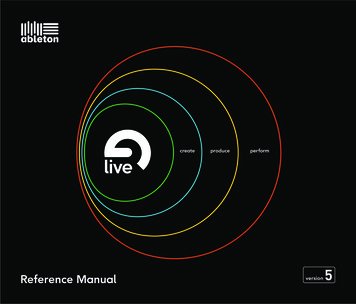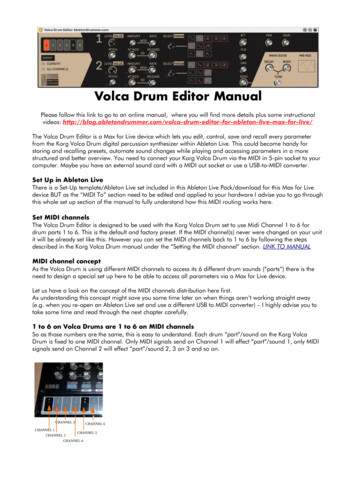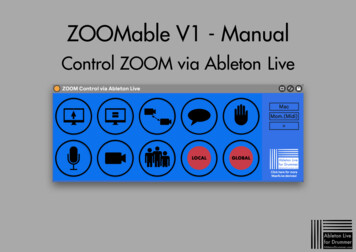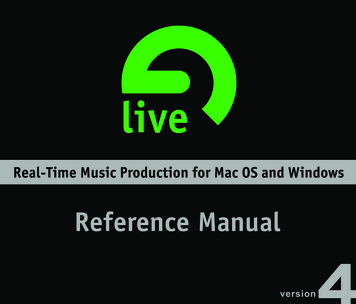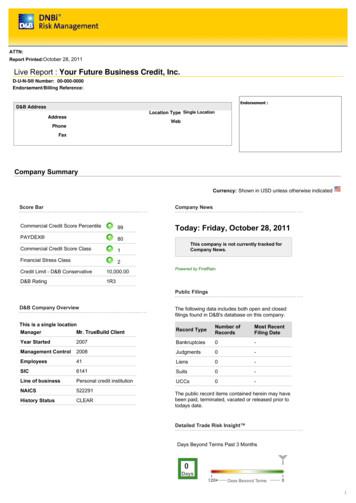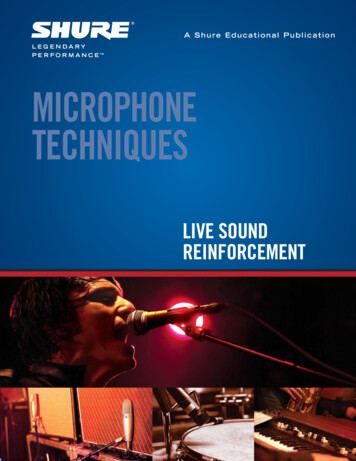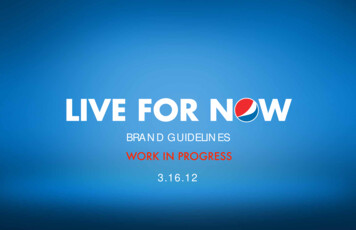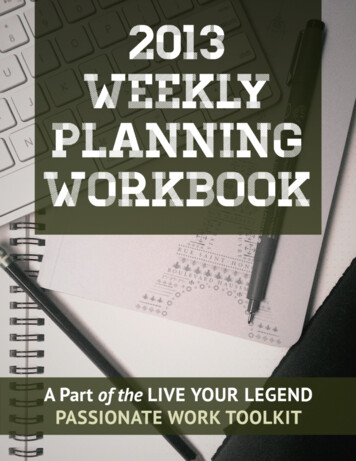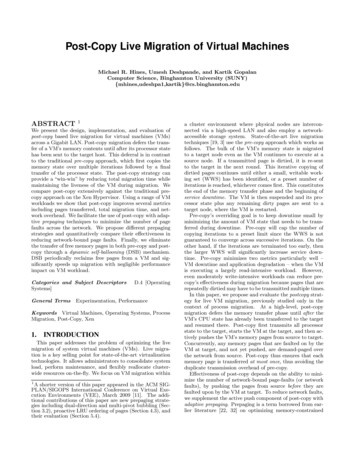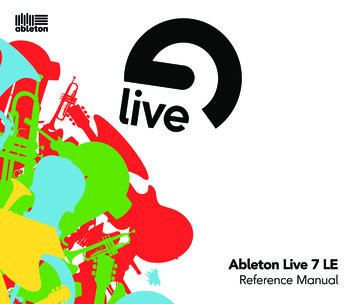
Transcription
Ableton Live 7 LEReference Manual
Live LE for Windows and Mac OSCreated by Bernd Roggendorf, Gerhard Behles, Robert Henke, Awi, Reiner Rudolph, Stefan Haller, Stefan Franke,Frank Hoffmann, Andreas Zapf, Ralf Suckow, Gregor Klinke, Matthias Mayrock, Friedemann Schautz, Ingo Koehne,Jakob Rang, Pablo Sara, Nicholas Allen, Henrik Lafrenz, Jan Buchholz, Kevin Haywood, Dominik Wilms, ChristianKleine, Amaury Groc, Daniel Büttner, Alex Koch, Henrik Hahn, Simon Frontzek, Torsten Wendland, Torsten Slama,Eduard Müller, Jeremy Bernstein, Bernard Chavonnet, Carl Seleborg, Claes Johanson, Bernhard Bockelbrink, NicoStarke, Jörg Kluÿmann.Reference Manual by Dennis DeSantis, Kevin Haywood, Rose Knudsen, Gerhard Behles, Jakob Rang, RobertHenke, Torsten Slama.Content provided by:SONiVOX www.sonivoxrocks.comBig Fish Audio www.big shaudio.comChocolate Audio www.chocolateaudio.comPuremagnetik www.puremagnetik.comPhysical Modeling technology provided by:Applied Acoustics Systems www.applied-acoustics.comCopyright 2008 Ableton AG. All rights reserved.This manual, as well as the software described in it, is furnished under license and may be used or copied only in accordance withthe terms of such license. The content of this manual is furnished for informational use only, is subject to change without notice,and should not be construed as a commitment by Ableton. Every effort has been made to ensure that the information in thismanual is accurate. Ableton assumes no responsibility or liability for any errors or inaccuracies that may appear in this book.Except as permitted by such license, no part of this publication may be reproduced, edited, stored in a retrieval system ortransmitted, in any form or by any means, electronic, mechanical, recording or otherwise, without the prior written permission ofAbleton.Ableton, Live and Live Pack are trademarks of Ableton AG. Apple, the Apple Logo, Mac, the Universal Logo, Mac OS, theAudio Units Logo, the QuickTime Logo and QuickTime are trademarks of Apple, Inc. Windows, Windows XP and Windows Vistaare registered trademarks of Microsoft Corporation in the United States and other countries. Intel is a registered trademark ofIntel Corporation or its subsidiaries in the United States and other countries. SONiVOX is the brand name trademark of SonicNetwork, Inc. VST and ASIO are trademarks and software of Steinberg Media Technologies GmbH. ReWire, ReCycle, REX andREX2 are trademarks of Propellerhead Software AB. AAS is a trademark of Applied Acoustics Systems DVM Inc. Mackie Control isa trademark of LOUD Technologies, Inc. OggVorbis and FLAC are trademarks of Xiph Org. All other product and company namesare trademarks or registered trademarks of their respective holders.
1Chapter 1Welcome to Live1.1The Ableton Team Says: Thank YouLive is the result of musicians wanting a better way to create, produce and perform musicusing a computer. A great deal of effort has been put into making Live easy and fun touse, yet at the same time capable of helping you create music with unlimited depth andsophistication. This effort continues even as you read these lines. in fact, a new, improvedLive version might already be available for download! Please check on our website now1 ,or choose the Check for Updates command from the Help menu.We hope you enjoy using Live and that it enhances your creative process. Should you havesuggestions about how we can improve Live, please let us know2 .Your Ableton Team.1 http://www.ableton.com/downloads2 contact@ableton.com
CHAPTER 1. WELCOME TO LIVE1.2What's New in Live 7?1.2.1Multiple Time Signatures2 Work with multiple time signatures in both Arrangement and Session view1.2.2Multiple Automation Editor Lanes View and edit multiple automation envelopes for a track simultaneously in the Arrangement View1.2.3Better Tempo Control Map song tempo to multiple controllers for coarse and ne adjustments1.2.4Ableton Effects and Instruments Drum Racks expand the Rack family with integrated return chains, choke groups, andother functions optimized for building drum kits Compressor replaces the former Compressor I and II devices with three compressionmodels, feedback, sidechaining and more. Spectrum performs realtime frequency analysis of incoming audio signals.1.2.5Device Improvements Sidechaining is available in the new Compressor effect, as well as the Gate and AutoFilter EQ Eight is updated with a larger display, a new notch lter, larger parameter rangesand an optional 64-bit hi-quality mode
CHAPTER 1. WELCOME TO LIVE Hi-Quality modes have also been added to the Dynamic Tube and Saturator effects3
4Chapter 2First StepsNote: This manual has been adapted for Live LE. Speci cally, this means that features whichare not available in Live LE have not been included. To learn more about the differencesbetween Live LE and the full version of Live, please see the feature comparison chart ordownload the full Ableton Reference Manual from the Ableton website1 . The full-versionreference manual also contains information about all of Ableton's add-on instruments.When you install Live and run it for the rst time, you will be presented with a dialog askingfor your Live serial number. Please see the chapter on unlocking Live should you havequestions or concerns during the authorization process.If you do not (yet) own Live, you can still try out all of Live's features, but you will not be ableto save or export your work.2.1Learn About LiveLive comes with a set of interactive lessons to take you step by step through the key featuresof the program. The lessons are organized in a table of contents, which can be opened1 http://www.ableton.com/downloads
CHAPTER 2. FIRST STEPS5directly in the program via the Help menu. We highly recommend following the lessons.Many users have told us that the lessons helped them become familiar with the programvery quickly.We also recommend that you read the Live Concepts chapter, which encapsulates everything that Live is and can do, and is therefore a worthwhile read for both beginners andexperienced users. The remaining chapters of this manual serve as in-depth reference forthe material introduced in Live Concepts.2.1.1Using the Info View and IndexLive's Info View tells you the name and function of whatever you place the mouse over. Forcertain items, you can create your own text and it will appear in this window.The Info View and itsShow/Hide Button.If you require more information on a speci c user interface element or topic, please consultthis reference manual. The index, found at the end of the manual, contains the names of alluser interface elements and will lead you to the relevant section.
CHAPTER 2. FIRST STEPS2.26Setting up PreferencesLive's Preferences window is where you can nd various settings that determine how Livelooks, behaves and interfaces with the outside world. This window is accessed from thePreferences command, which in Windows is available in the Options menu and in OS X, (PC) /is available in the Live menu. Preferences can also be accessed with the Ctrl, (Mac) shortcut.Live's Preferences are distributed over several tabs: In the Look/Feel tab, you can make various settings, including the language used fortext display and the color scheme, or skin, for the Live user interface. The Audio Preferences are used to set up Live's audio connections with the outsideworld via an audio interface. Please take the time to follow the program's built-inSetting up Audio I/O lesson, which will walk you through all the steps required toset up and optimize the settings for any given system. To access the lesson, use theLessons Table of Contents command from the Help menu. The MIDI/Sync Preferences are used to help Live recognize MIDI devices for twoseparate and distinct purposes:Playing MIDI notes. To learn how to route an external device into Live for MIDIinput, please see the Routing and I/O chapter.Controlling parts of the interface remotely. This subject is covered in detail in theMIDI and Key Remote Control chapter. The File/Folder Preferences pertain to Live's le management and the location ofplug-in devices. The Record/Warp/Launch Preferences allow customizing the default state for new LiveSets and their components, as well as selecting options for new recordings. The CPU Preferences include options for managing the processing load, includingmulticore/multiprocessor support. The Authorizations/Trial Preferences are used to manage licensing and installation ofthe Live platform, and add-on components like the Operator instrument.
CHAPTER 2. FIRST STEPS2.37The Main Live ScreenMost of your work in Live happens in the main Live screen. This screen consists of a numberof views, and each view manages a speci c aspect of your Live Set, which is the type ofdocument that you create and work on in Live. Since screen space is usually limited, theLive views can't all be displayed at the same time.Each one of the selector buttons at the screen borders calls up a speci c view; clicking thisone, for instance, opens Live's Device Browser:The Device BrowserSelector.To hide one of Live's views and free up screen space, click on the triangle-shaped buttonnext to it. To restore the view, click the button again.A View Show/HideButton.You can run Live in Full Screen Mode by selecting the Full Screen command from the Viewmenu. To leave Full Screen Mode, click the button that appears in the lower right corner ofthe screen. Full Screen Mode can also be toggled by pressing F11 . (Note: On Mac OSX, this key is assigned by default to Exposé, and will not toggle Full Screen Mode unlessExposé has been deactivated or assigned to a different key in OS X's System Preferences.)If one of the browser views is open, you can adjust the main window's horizontal split bydragging.
CHAPTER 2. FIRST STEPS8Adjusting the MainWindow Split.
9Chapter 3Unlocking LiveLive is protected against illegal use by a copy protection scheme. This scheme has beendesigned to meet the highest security standards while avoiding hassles for our customers. Ifyou nd this procedure to be an inconvenience, please understand that the copy protectionsecures your investment: It allows Ableton to provide you with support and to continuedeveloping Live.3.1Step 1: Entering Your Serial NumberThe rst time you run Live, you will be prompted to enter your serial number.As an owner of Live LE, you have received a serial number from Ableton, either via e-mail (ifyou ordered directly from Ableton), or on a card as part of the Live LE package.The serial number is composed of numbers 0.9 and letters A.F. If you accidentally typethe wrong string into a eld, the eld will turn red. When you have successfully enteredthe serial number, you can choose to either unlock online or from a le. Both options areexplained below.
CHAPTER 3. UNLOCKING LIVE10Please note that products such as Operator and Sampler are sold separately from Live butare unlocked using the same procedure described here. You can always enter any new serialnumbers and unlock additional products in the Authorizations/Trial tab in the Preferenceswindow. Live's Preferences are available via the Options menu (or the Live menu in Mac OSX).The serial number identi es your ownership of Live. Because your serial number is a valuablegood, you should keep it in a safe place and out of reach of unauthorized hands. Pleasebe aware that sharing your serial number will render it unusable. The only way for Abletontechnical support to help you get back your serial number if you lose it is via your registrationdata. Therefore, please register your product1 , as otherwise you might lose your property!3.2Step 2: Unlocking LiveThe second step of authorizing Live is called unlocking. Unlocking means associating yourserial number with a speci c computer. Please be aware that the standard Live license grantsyou the right to use Live on only one computer at a time. You can, however, unlock Livewith your serial number more than once under the legal and technical conditions describedlater.3.2.1The Unlock KeyFor unlocking, you require an unlock key that can only be created by the Ableton server.Unlocking therefore requires access to the Internet. The computer from which you connectto the Internet does not have to be the same computer for which you wish to unlock Live,but it does make things easier.3.2.2The Challenge CodeThe Ableton server creates the unlock key from your serial number and a so-called challengecode. The challenge code is a ngerprint that Live takes of your computer's components.1 http://www.ableton.com/register
CHAPTER 3. UNLOCKING LIVE11For details, please see the corresponding section.3.2.3Unlocking OnlineIf the computer you want to unlock Live for is connected to the Internet, the only thing youneed to do is press the Unlock Online button. Live will then create a connection to theAbleton server, send your serial number and challenge code, and receive the unlock keyfrom the server. No information other than this is exchanged between your computer andthe Ableton server.3.2.4Unlocking Of ineUnlocking Live Of ine.If the computer you want to unlock Live for is not connected to the Internet, you can useany other computer to access the Ableton server's web interface2 . This is a website withelds for entering your serial number and the challenge code, which you can copy fromLive's Unlock dialog.If you have entered your serial number and challenge code correctly, another website willappear to provide you with the unlock key. Follow the weblink to download the unlock keyas a le. Transfer the le to the target computer via some form of storage media, such as aUSB drive or CD-ROM. Then, press the Unlock dialog's Load Unlock Key button to load theunlock key le.2 http://www.ableton.com/unlock
CHAPTER 3. UNLOCKING LIVE3.33.3.112Copy Protection FAQsCan I Use Live or Other Ableton Products Without a Serial Number?If you do not (yet) own Live or its add-on products, you can still try them out, but saving andexporting will be disabled.If trying Live or another product raises your interest in purchasing it, please visit the Abletonwebshop3 . This site contains information about Ableton's distributor and dealer network. Italso offers you the opportunity to buy Ableton products online.3.3.2What if I Change My Computer's Components?If the challenge code of your computer changes for some reason, Live will indeed askyou to unlock the software another time. The challenge code does not change, however,when computer peripherals are replaced (audio or MIDI hardware, printers, modems). Thechallenge code may change if the motherboard, processor or network card is replaced. Onsome computers, reformatting a hard drive also changes the challenge code.3.3.3Can I Unlock Live More than Once?The standard Live license allows you to use Live on only one computer at a time. However,if you have registered your product4 , the Ableton server will provide you with two unlockkeys in good faith that you will use Live on only one machine at a time. Just proceed asdescribed in the corresponding section.You can therefore run Live on both a studio desktop computer and a tour laptop, but not atthe same time.Should the Ableton server reject your demand for another unlock key, please contact Ableton's technical support.3 http://www.ableton.com/shop4 http://www.ableton.com/register
CHAPTER 3. UNLOCKING LIVE13They can be reached by: E-mail5 ; Telephone: 49 (0)30 - 288 763 151 (available Monday to Friday 11 to 15hrs CET); Fax: 49 (0)30 - 288 763 11.To speed up the process, please: Register your copy of Live6 ; Include a brief explanation of the circumstances.To use Live on more than one computer at a time, you require a secondary license or a sitelicense. Ableton offers these licenses at special rates. Please contact the sales team7 fordetails.3.3.4Can I Play my Set from a Computer That Is Not Unlocked?Even if Live is not unlocked, you can still load and perform a Live Set with no time limitation.You cannot, however, save or export your work. When you go on tour, consider takingalong your Live program CD and a CD with the last state of your Live Set(s). In case of anemergency, you can install and run Live on any computer available and play your backupLive Set(s).3.3.5What Do I Do About Problems or Questions Regarding Copy Protection?Please contact technical support8 . They are happy to help!5 support@ableton.com6 http://www.ableton.com/register7 orders@ableton.com8 support@ableton.com
14Chapter 4Live ConceptsThis chapter introduces the essential concepts of Live. We advise you to read this chapterearly in your Live career, as a solid understanding of the program's basic principles will helpyou fully exploit Live's potential for your music-making.4.1Live SetsThe type of document that you create and work on in Live is called a Live Set. Live Setsreside in a Live Project a folder that collects related materials and can be opened eitherthrough the File menu's Open command or via the built-in File Browsers.A Live Set in the FileBrowser.
CHAPTER 4. LIVE CONCEPTS15Selecting the Library bookmark in Live's File Browser will take you to the Live Library ofcreative tools. There are a number of Demo Sets here, and double-clicking a Live Set'sname in the Browser will open that Live Set.4.2Arrangement and SessionThe basic musical building blocks of Live are called clips. A clip is a piece of musical material:a melody, a drum pattern, a bassline or a complete song. Live allows you to record and alterclips, and to create larger musical structures from them: songs, scores, remixes, DJ sets orstage shows.A Live Set consists of two environments that can hold clips: The Arrangement is a layout ofclips along a musical timeline; the Session is a real-time-oriented launching base for clips.Every Session clip has its own play button that allows launching the clip at any time and inany order. Each clip's behavior upon launch can be precisely speci ed through a number ofsettings.Clips in the Session View(Left) and in theArrangement View(Right).The Arrangement is accessed via the Arrangement View and the Session via the SessionView; you can toggle between the two views using the computer's Tab key or their respectiveselectors. Because the two views have distinct applications, they each hold individualcollections of clips. However, it is important to understand that ipping the views simplychanges the appearance of the Live Set and does not switch modes, alter what you hear orchange what is stored.The Arrangement andSession View Selectors.
CHAPTER 4. LIVE CONCEPTS16The Arrangement View and the Session View interact in useful (though potentially confusing)ways. One can, for instance, improvise with Session clips and record a log of the improvisation into the Arrangement for further re nement. This works because Arrangement andSession are connected via tracks.4.3TracksTracks host clips and also manage the ow of signals, as well as the creation of new clipsthrough recording, sound synthesis, effects processing and mixing.A Track in theArrangement View.The Session and Arrangement share the same set of tracks. In the Session View, the tracksare laid out vertically from left to right, while in the Arrangement View they are horizontalfrom top to bottom. A simple rule governs the cohabitation of clips in a track:A track can only play one clip at a time.Therefore, one usually puts clips that should play alternatively in the same Session Viewcolumn, and spreads out clips that should play together across tracks in rows, or what wecall scenes.A Scene in the SessionView.
CHAPTER 4. LIVE CONCEPTS17The exclusivity of clips in a track also implies that, at any on time, a track will either play aSession clip or an Arrangement clip, but never both. So, who wins? When a Session clipis launched, the respective track stops whatever it is doing to play that clip. In particular, ifthe track was playing an Arrangement clip, it will stop it in favor of the Session clip evenas the other tracks continue to play what is in the Arrangement. The track will not resumeArrangement playback until explicitly told to do so.The Back toArrangement Button.This is what the Back to Arrangement button, found in the Control Bar at the top of theLive screen, is for. This button lights up to indicate that one or more tracks are currently notplaying the Arrangement, but are playing a clip from the Session instead.We can click this button to make all tracks go back to the Arrangement. Or, if we like whatwe hear, we can capture the current state into the Arrangement by activating the Recordbutton. Disengaging Record Mode or stopping Live using the Stop button leaves us withan altered Arrangement.4.4Audio and MIDIClips represent recorded signals. Live deals with two types of signals: audio and MIDI. In thedigital world, an audio signal is a series of numbers that approximates a continuous signalas generated by a microphone or delivered to a loudspeaker. A MIDI signal is a sequenceof commands, such as now play a C4 at mezzo piano. MIDI is a symbolic representationof musical material, one that is closer to a written score than to an audio recording. MIDIsignals are generated by input devices such as MIDI or USB keyboards1 .It takes an instrument to convert MIDI signals into audio signals that can actually be heard.Some instruments, such as Live's Simpler, are for chromatic playing of one sound via thekeyboard. Other instruments, such as Live's Impulse, have a different percussion soundassigned to each keyboard key.1 For an introduction to digital audio and MIDI, please see http://img.uoregon.edu/emi/emi.php andhttp://www.midi.org/
CHAPTER 4. LIVE CONCEPTS18Audio signals are recorded and played back using audio tracks, and MIDI signals arerecorded and played back using MIDI tracks. The two track types have their own corresponding clip types. Audio clips cannot live on MIDI tracks and vice versa.Information about inserting, reordering and deleting audio and MIDI tracks is found here.4.5Audio Clips and SamplesAn audio clip contains a reference to a sample (also known as a sound le or audio le )or a compressed sample (such as an MP3 le). The clip tells Live where on the computer'sdrives to nd the sample, what part of the sample to play and how to play it.When a sample is dragged in from one of Live's built-in File Browsers, Live automaticallycreates a clip to play that sample. Prior to dragging in a sample, one can audition orpreview it directly in the Browser; the switch in the Browser with the headphone iconactivates previewing.Samples Are Dragged infrom Live's File Browsers.Live offers many options for playing samples in exciting new ways, allowing you to create anabundance of new sounds without actually changing the original sample all the changesare computed in real time, while the sample is played. The respective settings are made inthe Clip View, which appears on screen when a clip is double-clicked.
CHAPTER 4. LIVE CONCEPTS19An Audio Clip'sProperties as Displayedin the Clip View.Many powerful manipulations arise from Live's warping capabilities. Warping means changing the speed of sample playback independently from the pitch so as to match the songtempo. The tempo can be adjusted on the y in the Control Bar's Tempo eld.The Control Bar's TempoField.The most elementary use of this technique, and one that usually requires no manual setup,is synchronizing sample loops to the chosen tempo. Live's Auto-Warp algorithm actuallymakes it easy to line up any sample with the song tempo, such as a recording of a drunkenjazz band's performance. It is also possible to radically change the sonic signature of asound using extreme warp settings.4.6MIDI Clips and MIDI FilesA MIDI clip contains musical material in the form of MIDI notes and controller envelopes.When MIDI is imported from a MIDI le, the data gets incorporated into the Live Set, andthe original le is not referenced thereafter. In the Live File Browsers, a MIDI le appearsas a folder that can be opened to reveal its individual component tracks, which can beselectively dragged into the Live Set.
CHAPTER 4. LIVE CONCEPTS20MIDI Files Are Draggedin from Live's FileBrowsers.As you'd expect, a MIDI clip's contents can be accessed and edited via the Clip View, forinstance to change a melody or paint a drum pattern.A MIDI Clip's Propertiesas Displayed in the ClipView.4.7Devices and the MixerA track can have not only clips but also a chain of devices for processing signals. Doubleclicking a track's title bar brings up the Track View, which shows the track's device chain.
CHAPTER 4. LIVE CONCEPTS21The Track ViewDisplaying a MIDI Track'sDevice Chain.Live's built-in audio effects, MIDI effects and instruments are available from the DeviceBrowser and can be added to tracks by dragging them from there into the Track View, orinto a Session or Arrangement track.Live's Built-in DevicesAre Available from theDevice Browser.You can also use plug-in devices in Live. VST and Audio Units (Mac OS X only) Plug-ins areavailable from the Plug-In Device Browser.
CHAPTER 4. LIVE CONCEPTS22Plug-In Devices AreAvailable from thePlug-In Device Browser.Consider an audio clip playing in an audio track. The audio signal from the clip reachesthe leftmost device in the chain. This device processes (changes) the signal and feeds theresult into the next device, and so on. The number of devices per track is theoreticallyunlimited, (although there is a limit of eight instruments and twelve audio effects within asingle set when using Live LE). In practice, the computer's processor speed also imposes alimit on the number of devices you can use at the same time, a topic that deserves separatediscussion. Note that the signal connections between audio devices are always stereo, butthe software's inputs and outputs can be con gured to be mono in the Audio Preferences.When the signal has passed through the device chain, it ends up in Live's mixer. As theSession and Arrangement share the same set of tracks, they also share the mixer. The mixercan be shown in both views for convenience. To optimize the screen layout, the individualmixer sections can be shown or hidden using the View menu's entries.The Live Mixer in theArrangement View (Left)and Session View (Right).
CHAPTER 4. LIVE CONCEPTS23The mixer has controls for volume, pan position and sends, which adjust the contributioneach track makes to the input of any return tracks. Return tracks only host effects, and notclips. Via their sends, all tracks can feed a part of their signal into a return track and shareits effects.The mixer also includes a crossfader, which can create smooth transitions between clipsplaying on different tracks. Live's crossfader works like a typical DJ mixer crossfader, exceptthat it allows crossfading not only two but any number of tracks including the returns.Live's Crossfader.Devices that receive and deliver audio signals are called audio effects. Audio effects are theonly type of device that t in an audio track or a return track. However, two more types ofdevices are available for use in MIDI tracks: MIDI effects and instruments.Consider a MIDI track playing a clip. The MIDI signal from the clip is fed into the track's devicechain. There, it is rst processed by any number of MIDI effects. A MIDI effect receivesand delivers MIDI signals. One example is the Scale effect, which maps the incomingnotes onto a user-de ned musical scale. The last MIDI effect in the chain is followed by aninstrument. Instruments, for instance Live's Simpler and Impulse, receive MIDI and deliveraudio. Following the instrument, the signal can be additionally processed by audio effectsas in an audio track.A MIDI Effect, anInstrument and an AudioEffect in a MIDI Track.If a MIDI track has no instrument (and no audio effects), then the track's output is a plainMIDI signal, which has to be sent somewhere else to be converted into audio. In this case,
CHAPTER 4. LIVE CONCEPTS24the track's mix and Send controls disappear from the mixer.The Mixer for a MIDITrack without anInstrument.4.8Presets and RacksEvery Live device can store and retrieve particular sets of parameter values as presets. Aspresets are stored independently from Live Sets, new presets become part of a library thatany project can draw from.Live's Instrument, Drum and Effect Racks allow saving combinations of devices and theirsettings as a single preset. This feature allows for the creation of powerful multi-devicecreations and effectively adds all the capabilities of Live's MIDI and audio effects to thebuilt-in instruments.4.9RoutingAs we have seen, all tracks deliver signals, either audio or MIDI. Where do these signalsgo? This is set up in the mixer's In/Out section, which offers, for every track, choosers toselect a signal source and destination. The In/Out section, accessible through the Viewmenu's In/Out option, is Live's patchbay. Its routing options enable valuable creative andtechnical methods such as resampling, submixing, layering of synths, complex effects setupsand more.
CHAPTER 4. LIVE CONCEPTS25Track Routing Is Set upUsing the In/Out Sectionin the Arrangement (Left)or Session View (Right).Signals from the tracks can be sent to the outside world via the computer's audio and MIDIinterfaces or to other tracks or devices within Live.Likewise, a track can be set up to receive an input signal to be played through the track'sdevices. Again, tracks can receive their input from the outside or from another track ordevice in Live. The Monitor controls regulate the conditions under which the input signal isheard through the track.4.10Recording New ClipsAudio tracks and MIDI tracks can record their input signal and thereby create new clips.Recording is enabled on a track by pressing its Arm button (Hold down the Ctrl(PC) /(Mac) modi er to arm several tracks at once). If the Exclus
download the full Ableton Reference Manual from the Ableton website1. The full-version reference manual also contains information about all of Ableton’s add-on instruments. When you install Live and run it for the rst time, you will be presented with a dialog asking for your Live serial number.
